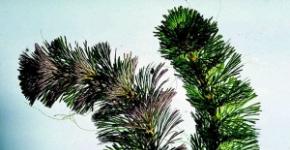Black and white ladybug. Everything about ladybug
Our beneficial insects , underrated pest control allies. And although they may, at first glance, seem very small, tender and defenseless, in a short period of time they can destroy surprisingly many pests.
One of the most important beneficial insects in our country is the beetle, called - ladybug (lat. Coccinellidae).

This small, brightly colored predator scutes, in our country, the most numerous and under favorable conditions, can free many plants from pesky insects. Most pests eat ladybird larvae , up to the moment of becoming an adult, can consume from 400 to 3 thousand aphids. Adult ladybugs, who eat more than 200 different insects every day, have a much smaller appetite.
The main food is, but the ladybugs are not particularly picky and willingly take the opportunity to profit from leaf beetles, hymenoptera sawflies and horntails, mites, worms and shield insects, or Diptera larvae. Such a serious ally can not be ignored by us, so you should take a closer look at him to create the best conditions for his life in our garden.
Types of Ladybugs
Ladybug each is associated with a small insect with a bright red shell, with several black dots. This is only one of many of his images, since there are more than 5 thousand types of ladybirds in the world, of which we have more than seventy.
The most common are of course Two point (lat. Adalia bipunctata) and Seven-point (lat. Coccinella septempunctata), with a typical red shell for us, but besides them there are also insects with orange-red shell and black dots - Ten-point, (lat. Adalia decempunctata), red shell and black dots, with a yellow rim in a circle - Mottled cow (lat. Anatis ocellata), black shell and yellow or red dots - Fourteen spotted cow (lat. Coccinula quatuordecimpustulata), yellow or cream shell and black dots - Twenty-two-point koroovka , or psillobor , orange shell and cream points - Calvia ten spotted (lat. Calvia decemguttata).
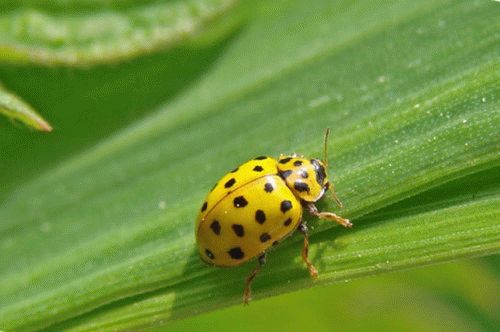
Like adult individuals, the larvae also differ among themselves, while their appearance is not at all like any of the parents. Ladybird Larvae small, but at close range, they look very scary, resembling small crocodiles or miniature monsters. Pupae can be easily confused with the Colorado potato beetle. In general, the body of the larva is sectional, gray-black with yellow or orange spots, but there are species in which yellow larvae have a black speck.
Because of their unusual appearance, the offspring of ladybugs can often be mistaken for pests and destroyed. Therefore, before we decide on radical measures, you should observe the insects.
Interestingly, not all predators known to us are ladybirds, because some (ex. TO about twenty-two point), can eat fungi (powdery mildew), and even plants (one of the few pests belonging to ladybugs - Alfalfa twenty-four cowi (lat. Subcoccinella vigintiquatuorpunctata).
The life cycle of the development of a ladybug
The development cycle of a ladybug is rather complicated. An adult female, after fertilization, lays oblong, yellow-orange eggs. Attaching them to different parts of plants, as a rule, closer to the power source, for example. . One female can lay more than 1000 eggs for a short life (about 1-1.5 years). The larvae hatch from the eggs, which then develop into pupae, and then, into an adult ladybird (from the moment of laying the eggs until the appearance of a mature insect in our climate takes about 40-60 days).
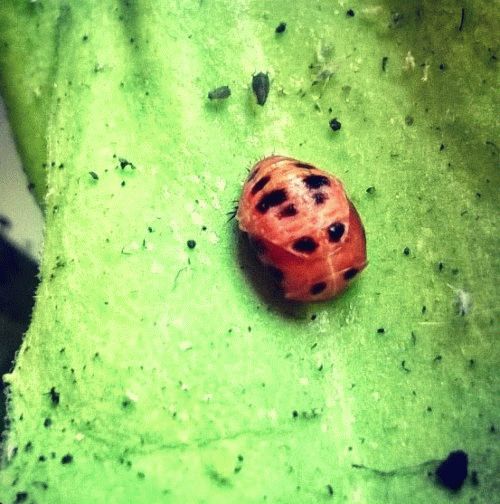
In the fall, adult insects are looking for secluded and warm places where they can safely spend the winter. As a rule, they choose the bark of trees, stones, composting, piles of leaves or needles, but sometimes they can also hide in window crevices or window sills, but in such a shelter they rarely wait for spring, because they usually dry out.
Ladybug on the plot.
The insect is independent and it is difficult to predict where it will decide to settle, therefore, if we want to have it in our garden, we should try a little. First of all, you can not use in the country any chemical plant protection products or choose those that are not harmful to the ladybirds. In addition, it is necessary to allocate a small space in the garden, in which we will not interfere (we stop mowing the grass, raking leaves).
Thus, we create a favorable environment not only for the ladybirds, but also for many useful insects, such as the golden-eyed, spiders and ants, which in such a place can freely reproduce, develop, and hibernate. If such a wild nook will spoil the view of the garden, you can close it with a decorative wooden fence or an original fence.
Remarkably, these inconspicuous insects also have their secret weapon to protect against enemies. Feeling dangerous, they emit a yellow, unpleasant smell, a substance that should scare off the enemy.
The reputation of our allies, in recent years has been slightly "stained", because of one of its relatives Harmonia axyridis, the people - " And the ladybird of Asia". It is more aggressive and reproduces faster than ours, “domestic”, therefore it represents a greater threat to them. It happens that an Asian ladybug bites people, causing an unpleasant burning sensation at the site of the bite, and sometimes allergies. And although this species is really annoying and alien to us, it should not affect the reputation of the whole genus, these beautiful and useful insects.
If you have something to add, please be sure to leave your comment.
With the arrival of spring and summer in nature appears a lot of different insects. Kids love to watch beautiful beetles. Making a walk on the nature with children, you can definitely meet beautiful bugs, with black dots. Among the huge variety of large and small bugs, which are busily scurrying around the gardens, fields and gardens, people enjoy the sympathy of ladybugs. Consider these bugs and tell about the ladybug to children.
Why bugs are called gods, why cows, if they are bugs, why they have such a color, what benefits they bring and how they develop.
The story to children about the ladybird
These little bugs have a very attractive bright appearance. Their coloring is remembered at first sight. These insects have long deserved human interest.
In many countries, various legends and superstitions are associated with them, people invented proverbs and fairy tales about them.
We call them "ladybug." In some countries of Eastern Europe, these bugs are called affectionately "sun", and in Western Europe - "the bug of the Virgin Mary."
Where do bugs live? Everywhere except Antarctica. There are also here, in the countries of Northern, Western and Eastern Europe, Intdia, Great Britain, Italy and France.
Why are beetles called divine? God means meek, safe. Why a ladybug if she is a bug? When she sits quietly in the palm of a person, she is safe. And if you press it a little, the insect emits yellow “milk”, liquid. Therefore, it was called the ladybird.

In general, beetles are predators. Ladybirds or cokcenilides (as the Latin calls the family of beetles), like their larvae, feed mainly on aphids. For this, they are also called aft cows. In addition to aphids, ladybugs and their larva destroy the insects, spider mites, small caterpillars, insect egg-laying, i.e. the most dangerous pests of agriculture.
Bugs are very active, run quickly through the plants and can fly over long distances.
The bugs have a very enviable appetite. Every day you need about fifty aphids.

The larvae of the ladybirds also do not complain about the lack of appetite: their development requires about a thousand aphids. Larvae grow very quickly. For the year may develop several generations.
Appearance of a ladybug
They look very bright. Their round back is painted in red, orange or yellow and covered with dotted spots. Points can be a different number. There are individuals with two points, from 12, 30. The most common is a seven-spotted ladybug.
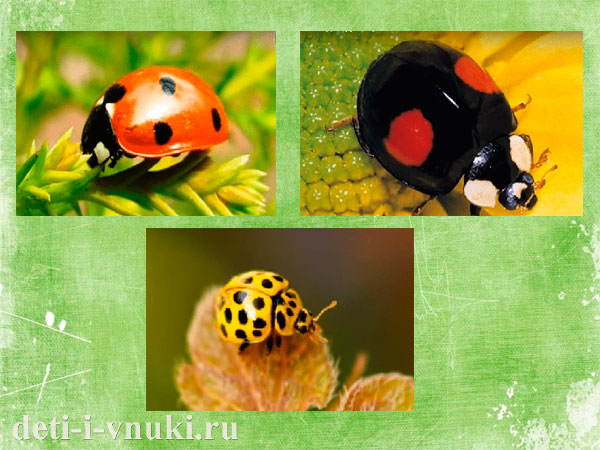
By the way, the 28-point person is a vegetarian and a pest: he eats potatoes, beets and clover.
Bright signs make the ladybugs easily recognizable even by small children.
Entomologists consider ladybirds and those who have commas on their backs, dashes, others have a fancy ornament. There are beetles even in black attire, and not only in a red or yellow suit. And they also have pea points. Ladybirds are more than 4000 different species.

Ladybirds have a head, pronotum, chest, abdomen, 3 pairs of paws, rigid elytra and wings transparent, with the help of which the insect flies. Eyes of large size and movable antennae.
A bug flies with the help of two rear wings, and hard elytra serve as protection.
Video - Slow Motion as a Ladybug Takes Off
During flight, the insect makes up to 85 strokes per second. And it will be interesting to children to see that transparent wings are hiding under the rigid sheaths with the help of which the fly is flying.
Why is the insect such a bright outfit? To defend against enemies! This is a warning coloring: “I'm not edible!” She says.
If you pick up a bug and inadvertently squeeze it, then it will release an orange drop. It contains cantharidin poison. it is not dangerous for people, but if a bird grabs a ladybird, it will burn its throat in such a way that it no longer wants to touch it. So the little insect feels safe.
How does a ladybug develop
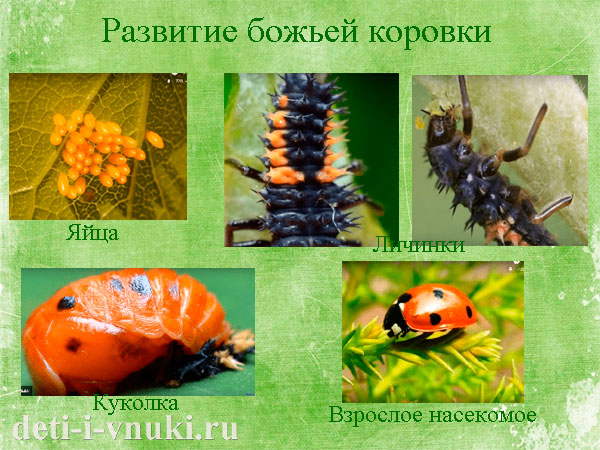
In the spring of insects begin trouble with the breeding of offspring. They are looking for a mate. On the leaves of plants, the female lays up to 400 eggs, yellow.
The female, taking care of her offspring, selects plants that grow near the habitats of aphids. After 1-2 weeks of the eggs appear larvae. At first they feed on the shell of the egg, as well as unfertilized eggs. Then they get to the aphids. The larval stage lasts 4-7 weeks. When the larvae accumulate feeding substances, they turn into pupae. The pupa is attached to the sheet. After 7-10 days, an adult insect crawls out of the shell of the pupa. He has no spots yet. The bug sits and waits. Then there is a color matching and spots.
Adult bugs usually overwinter. They are thermophilic. If the climate is cold, the ladybugs gather in flocks and fly away to warm lands. If they stay, they gather in colonies and hide under stones, bark of trees, and so wait the winter cold.
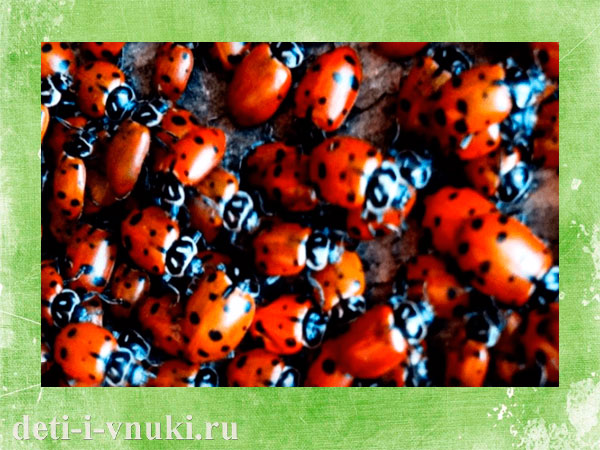
The benefits and harm of ladybirds
The voracity of ladybirds is of great benefit to gardens and orchards in many countries. If one larva eats 50 individuals of aphids per day, then an adult insect - up to 100 individuals.
Beetles are specially bred and then sprayed over the gardens with the help of aviation.
But there are harmful individuals that eat vegetables.
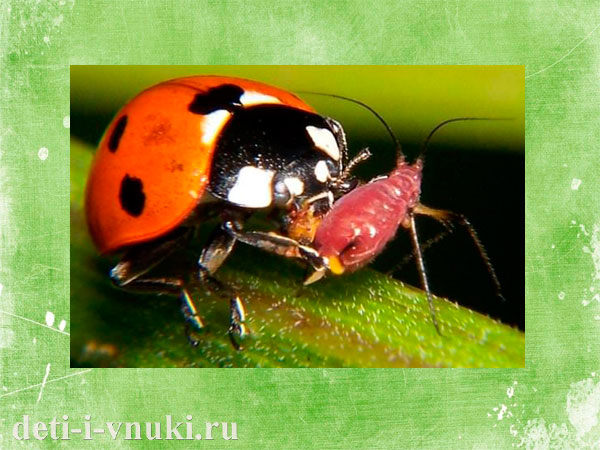
- From ancient times, even ladybirds were worshiped. Slavs considered her a messenger of the goddess of the sun.
- With its help, predicted the weather. If the bug flies away from the palm on which it was sitting, then the weather will be good. And if you do not want to fly, there will be bad weather.
- Long since in Western countries, people considered the ladybird a symbol of good luck. The images of the bug on the clothes were like a charm.
- Many will take associated with this bug. If a ladybug flies to you, do not hurry to chase it away so as not to frighten away the fortune. Flying into the house, she promises peace and harmony, and for childless families, the appearance of a child.
Cartoon for kids
Coloring for kids
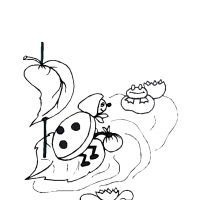
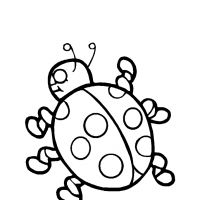

And Julia drew this ladybird to the contest for Nina Kuzmenko’s blog.
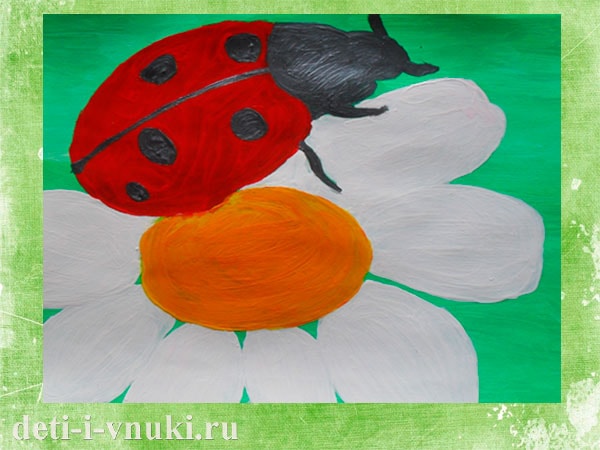
That's so interesting, you can hold a conversation with children and talk about a familiar bug, called a ladybug.
Children love these insects, read poems about them, make different crafts.
Soon for children I will make a selection of poems and riddles about the ladybird.
Come visit, write your comments, it is very important for me to know your opinion. Share information with friends by clicking on the buttons social. networks.
Best regards, Olga.
Materials on the topic:

How animals in the forest prepare for winter
Good afternoon, dear readers! In the fall, you often walk with your children in the park, forest. Have a conversation, tell the children how the animals are preparing for winter. Let the child remember what ...

Children about the sunflower sun flower
Each of us has known a ladybug since childhood. This is a red bug, on the back of which there are black markings. In points taken insect. However, this opinion is deeply mistaken, and the number of specks is in no way connected with the age of the beetle. How many points have a ladybug and what exactly does their number mean? The answer to this question will be devoted to the article.
Where did the name of the insect come from?
Before finding out how many points a ladybug has, it is interesting to find out why the insect was called this way.
How many points have a ladybug and what does it depend on, let's try to figure it out.
general characteristics
The size of the beetle is from 4 to 10 mm. The little body is round, convex at the top. There is a head, pronotum, chest, six legs, abdomen, wings and elytra. On the head there are large eyes and flexible antennae, which allow the insect to feel everything.
The bug has a bright color that serves as a kind of protection from enemies. Its color can be yellow, red, black, blue. There are spots of black, red, yellow, white. Sometimes they merge and form patterns. Some representatives have no spots at all.
How many points a ladybug will have on its back depends on the type of insect, but does not indicate the age of the bug. Often the pattern on the pronotum can recognize the floor of the beetle. 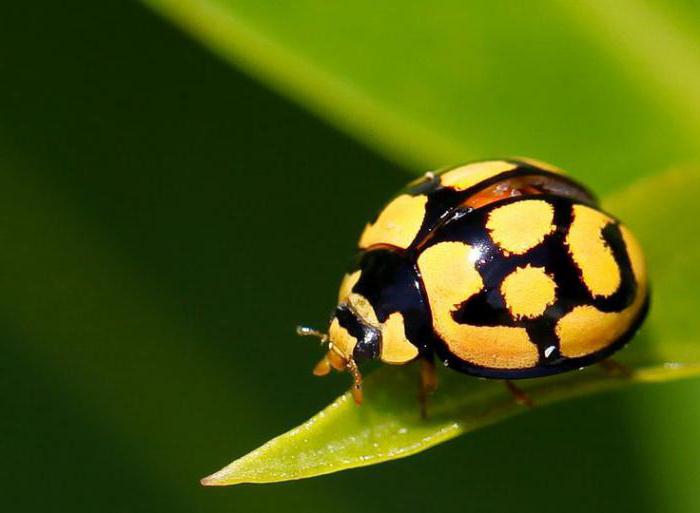
Known species
The family of bugs has more than 4,000 species, united in 7 subfamilies and 360 genera. The most famous varieties:
- Two point. This is a red beetle and two black dots 5 mm long. The pronotum is black with a yellow border on the sides.
- Seven-point variety. By the name it is clear how many black dots have a ladybug of this type. The most common beetle. It has a red color, black dots, length 7-8 mm.
- Ladybug with 12 points. The beetle is 6 mm long, pinkish or red, with 6 points on each of the elytra.
- Beetle with 13 dots has a length of 4-7 mm, red-brown in color, the spots merge.
- Insect with 14 dots. The beetle is yellow or black with dots of black or yellow color.
- Seventeen point variety. The length of the beetle is 2-4 mm, the color is yellow or dark yellow. It is found in Europe.
So, now it becomes clearer how many dots on the sheaths of ladybirds and how this is explained. It depends on the type of insect. 
I wonder how many black dots on the elytra of ladybirds are more common? Red bugs with seven spots are considered the most common in nature. However, the diversity of species of these insects is so extensive that ladybugs with a minimum number of spots are known - they are two-point. Well, the maximum number of points on the elys of insects - 24.
Since long, many stories and legends are associated with ladybirds.
In ancient times, the insect was considered the messenger of the sun deity. With the help of the red bug, they even tried to predict weather conditions. If the beetle left the palm, it foreshadowed a sunny day. If he remained on hand, it promised bad weather.
In some countries it is forbidden to destroy these insects, so as not to expose themselves to attacks. 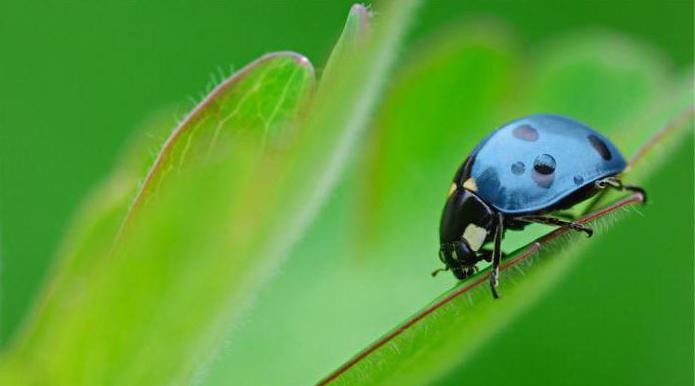
Figure ladybug was considered a symbol of good luck. It was applied to clothing and jewelry. Such images played the role of talismans and protected their owner from failures.
There are many signs associated with insects. For example, in no case should one chase away a ladybird that has flown in, so as not to frighten away fortune. The lady who flew into the house brings harmony and happiness to the family. The emergence of a beetle promises childless families the speedy birth of a baby. If you count how many black dots on the sheaths of ladybirds, you can determine how many happy months are expected next year.
Every year, bugs fly for wintering, and the places they choose are the same. Scientists have so far not been able to unravel this phenomenon. After all, the life of insects is short, and new offspring of bugs are flying for the winter. How they manage to fly to the same region is unknown.
There are cannibals and eat their own relatives, who have not hatched yet.
- one of the large families of the beetle order, numbering more than 5,000 species, of which about 2,000 are found in the Palearctic. On the territory of the former USSR 221 species are noted, of which about 100 live in Russia. Small-sized beetles - imago body length from 1 to 18 mm. The body is usually rounded oval, strongly convex, almost hemispherical (the underside is almost flat or slightly convex). In some groups, the body is oblong-oval, flattened to one degree or another. The surface of the body is often naked, less often - covered with hairs.Head
small, may be stretched in the longitudinal or transverse direction.Eyes
large, often with a notch in the front edge. Antennae 8-11 segmented, short or medium length, with mace (more often) or without it. Anterior and mesothorax transverse.
Posterior thorax broad, almost square, much longer than mesothorax.
. Legs
moderate length, covered with thick hairs. The paws are hidden 4-segmented (seem to be 3-segmented, since the 3rd segment is small and hidden in the lobes of the 2nd) and only the representatives of the Lithophilini tribe have paws clearly 4-segmented.Pronotum
wider than the head, convex, transverse, with a notch of various shapes at the front edge. Often - with spots or a pattern of merged spots.Elytra
red, yellow, brownish with black or white spots, which, sometimes merging, form a changeable pattern; or elytra black with red or yellow spots.Abdomen
the bottom is almost completely flat, the top is much more flat than the elytra, and consists of 5-6 visible sternites. Sexual dimorphism is weak. Sometimes females and males differ in pattern on pronotum.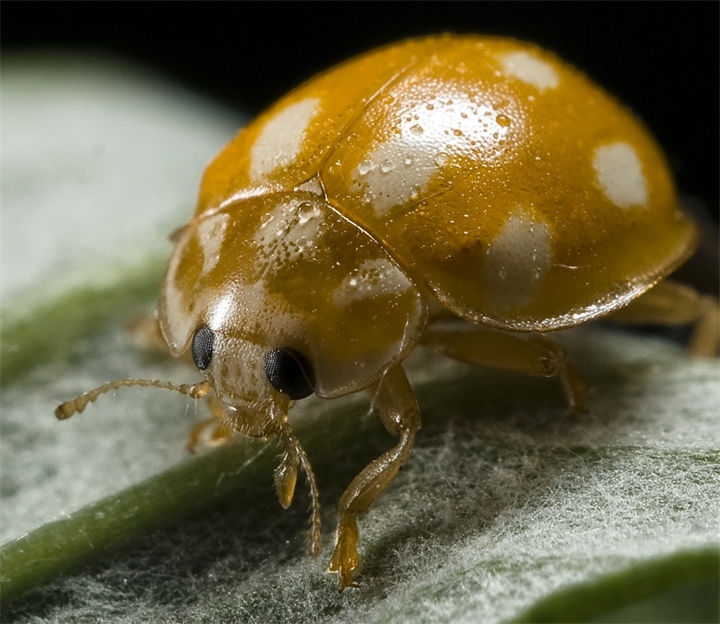
Yellow ladybug
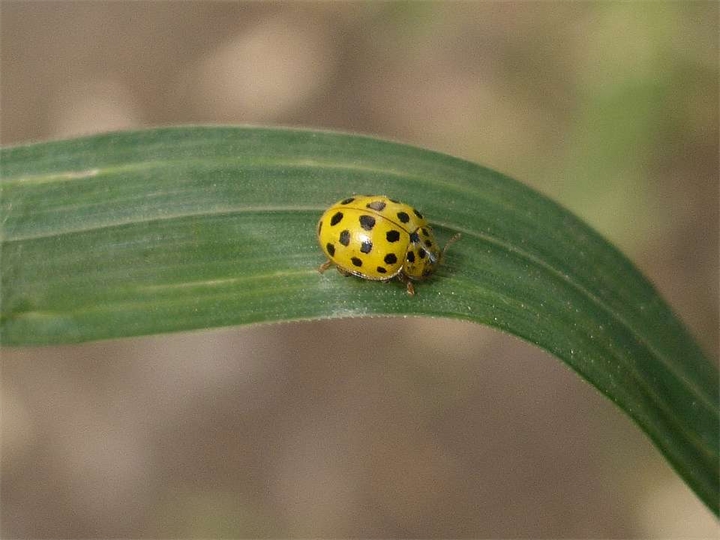
Eggs are usually oval
, slightly tapered towards the ends. In species of the tribes Stethorini and Chilocorini - short, almost rounded. Egg color is yellow, orange, whitish; surface often shagreen. The egg-laying is usually dense, the eggs are located in more or less regular rows, touching each other sideways. In some individuals of Harmonia sedecimnotata, the egg-laying is “loose”, the eggs are spaced from each other by a distance equal to 1–1.5 in diameter of the egg.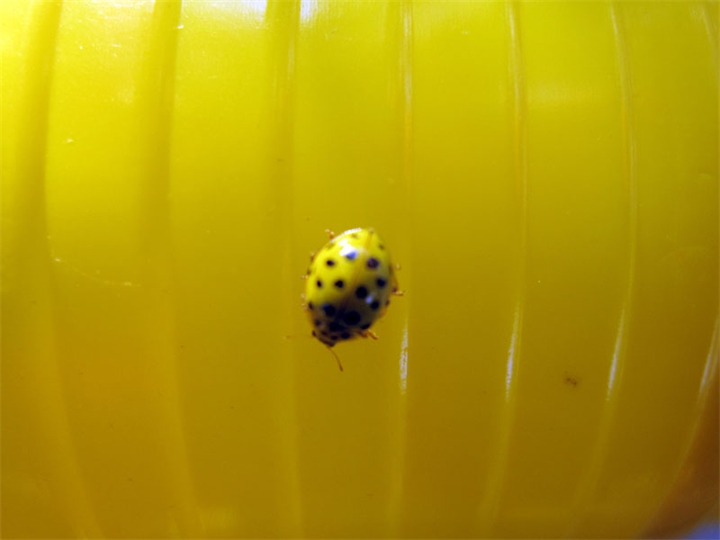
Yellow ladybug
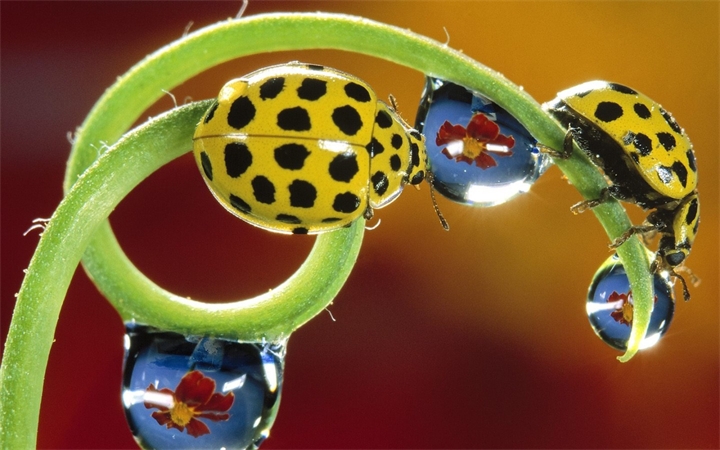
Larvae
more or less campoids, elongated, sometimes flat and oval. In the larvae of the cows that feed on cherries, the body is covered with waxy threads of white color. The larvae are often variegated, the pattern is formed by orange, yellow or white spots. The surface of the body is covered with hairs, bristles, warts and other outgrowths. Larvae in their development are 4 age.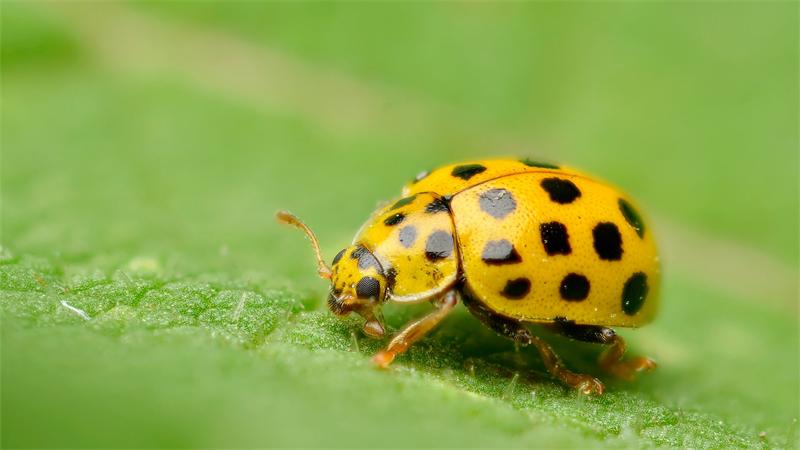
Pupae
free, attached to the substrate with the remains of the larvae. Often have a bright color with black, yellow and white spots. For the Coccinellini tribe, an open type is characteristic - the pupa is located in the larval burst that burst from the dorsal side. In Chilocorini, the half-closed type — the larval covers partially burst and expose only the back of the pupa. In Hyperaspini, pupae are located under the larval pelt.
Bright coloring of ladybirds
- red or yellow with black dots has a protective function, warning possible predators, such as insectivorous birds, that ladybugs have a very unpleasant taste. If you touch a ladybird, it will release a drop of bitter, pungent fluid from foot joints and other parts of the body. This liquid, usually yellow, blurs the unwary hand and leaves an unpleasant odor on the skin for a long time.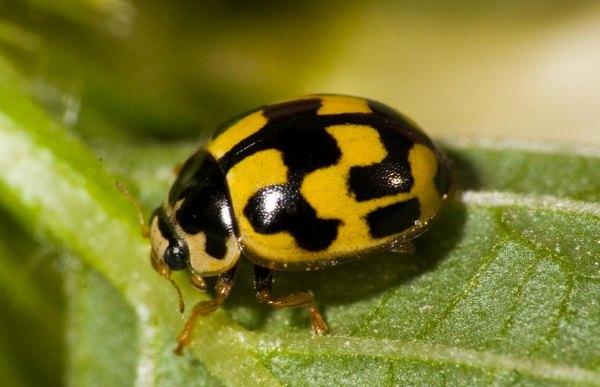
In children, a ladybug is considered to be a very trusting creature. In Russia, England and Denmark there is a game - a child catches a ladybird and reads a poem to her:
Ladybird, fly to the sky,
Bring me some bread.
Black and white
Only not burnt.
Or
Ladybug, fly to the sky,
There your children eat candy,
One by one
And you no one.
If the ladybug flies away, then she believed it. In England, the rhyme is more cruel:
Ladybug, fly to heaven
Your house is on fire, your children are alone
from "The Adventures of Tom Sawyer" by Mark Twain
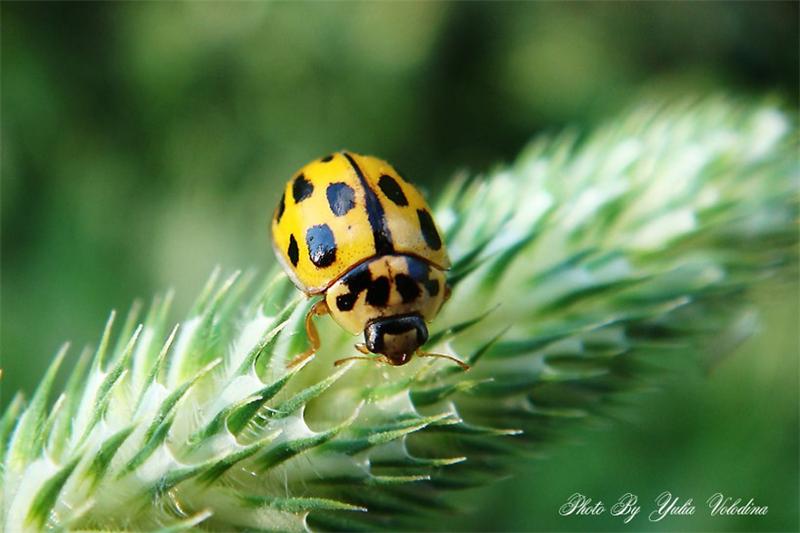
In Denmark, children ask the Ladybird to ask God for good morning weather.
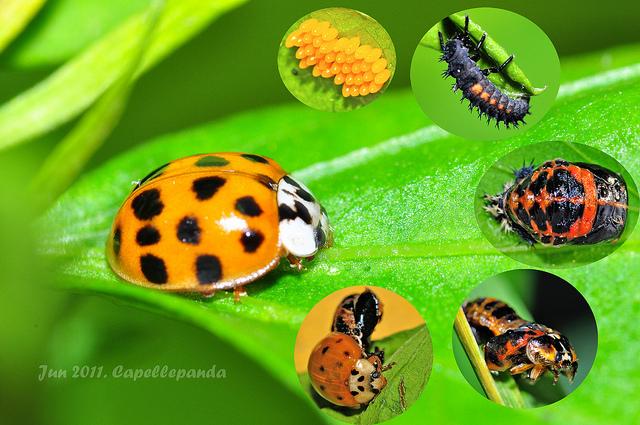

Anatomy of a ladybug
The body of a ladybug has the shape of a hemisphere. From the bottom it is flat, and at the top is strongly convex. The size of this insect can vary from 4 to 10 mm. The color of a ladybird depends on its appearance - it can be from monophonic to very colorful. In total there are more than 4,000 insect species of ladybirds. The most common color is a red back with black dots that can be from 2 to 22. A ladybug has six legs, two antennae, two large eyes, two wings and two elytra, which protect the main wings from damage on the ground, when the ladybird does not fly.
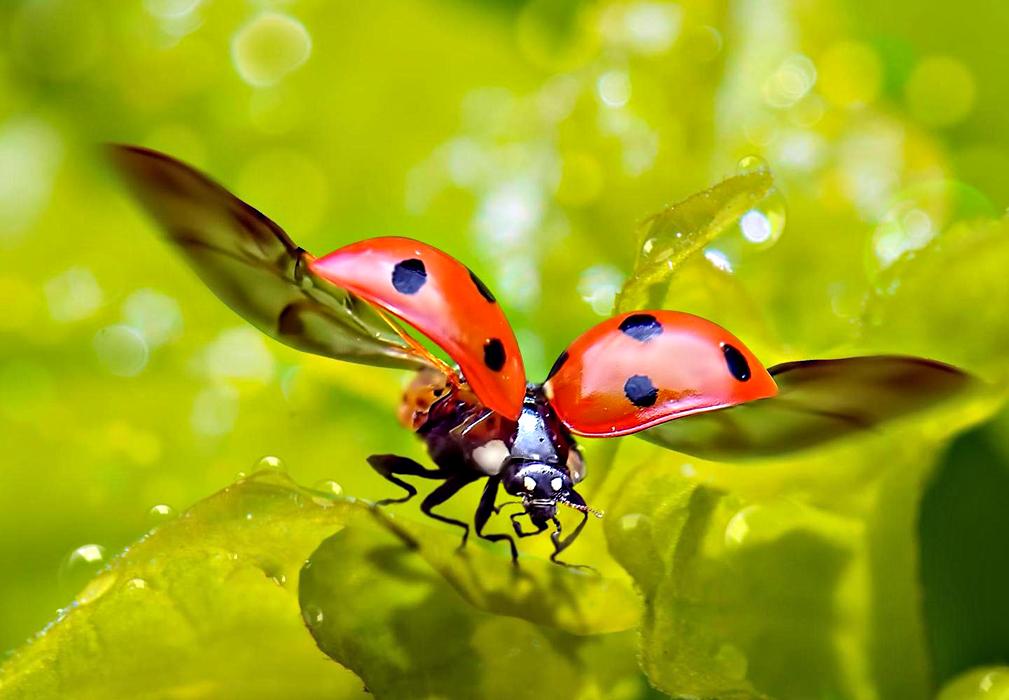
In juveniles, the coloring is brighter. With age, it fades. Protection of the ladybirds is a yellow, poisonous liquid that has an unpleasant odor, which they release when danger arises.
Family: Ladybugs
Class: Insects
Detachment: Coleoptera
Type: Arthropods
Kingdom: Animals
Domain: Eukaryotes
Where does a ladybug live?
Insect Ladybug is spread all over the world and such an insect can be found on all continents of the planet, except Antarctica. The preferred places are meadows, grassy meadows. But they can also occur in forests.
What feeds a ladybug?
Most of the representatives of God's cows are predators, and only a few species are herbivorous, which can only eat certain types of plants. Predators, on the other hand, feed on small insects such as aphids, whiteflies, spider mites, and sometimes even attack caterpillars. They also eat, not only these insects, but their eggs and larvae.
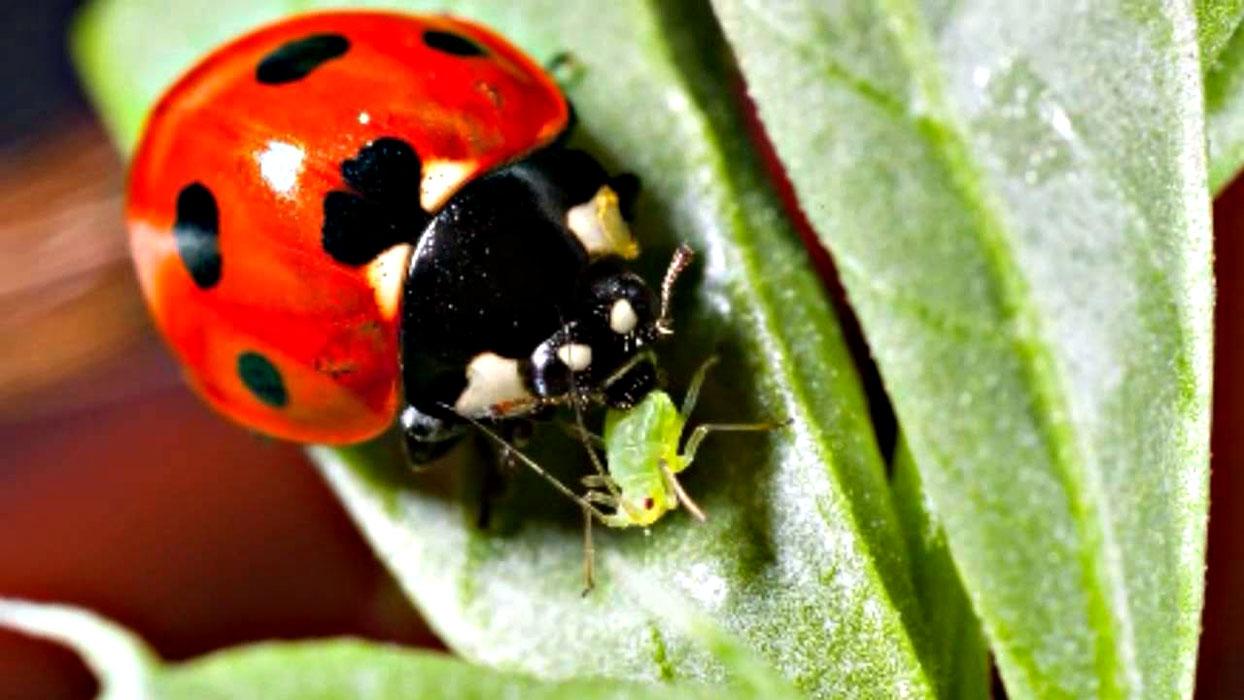
Lifestyle
Ladybirds live mostly singly. In the warm season, they lead an active lifestyle, and in the cold season, on the contrary, they gather in groups and spend the winter under foliage or under stones, hibernating. In this case, the number of groups can reach large sizes, and all insects are tightly pressed against each other. The life span of a ladybug is from several months to 2 years.
![]()
Breeding
Ladybirds multiply several times a year. The female lays 200 to 1,500 yellow eggs close to a clump of aphids or other food of the ladybirds to provide their larvae with food.
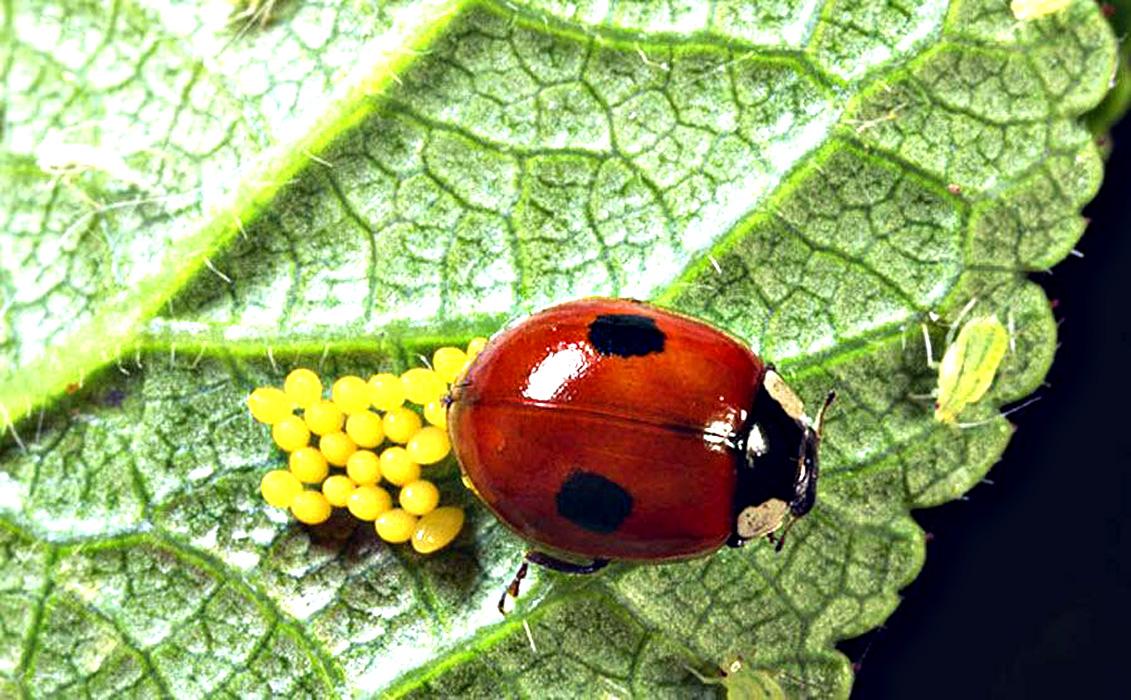
Ladybird larvae have an elongated body, often gray, and develop from several weeks to 3 months. Like the parents, the larvae eat a lot and are quite mobile.

Insect Ladybird is considered a useful insect for humans, as it eats harmful insects that can harm the crop. In many of the names of these insects in other languages of the world there is a definition of divinity: “God's cattle”, “God's sheep”, “Ladybugs”, etc.
If you like this material, share it with your friends on social networks. Thank!


